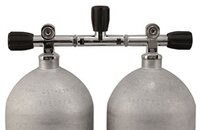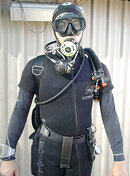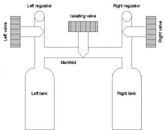The manifold is the 'bar' that joins the two cylinders (see below). Its purpose is to enable two tanks to work as one 'virtual' tank - delivering the full contents of both tanks to either regulator.

Divers attach a regulator to both tank valves. Typically, these are DIN fitting regulators. These regulators are then used in a normal fashion, with one regulator (the 'primary') in the divers' mouth and a reserve regulator (the 'secondary') fulfilling the role of an alternate-air-source (AAS).
When using double cylinders, many divers prefer to use a long (5' or 7') hose as their primary and a short (22 - 24") hose as their secondary. In this instance, they will donate their primary 'long' hose to an out-of-air diver and then transfer to breathe from their own secondary regulator. The secondary regulator is typically secured on their neck, using a necklace made out of bungee cord. The long hose is kept streamlined by routing it around the body and behind the neck. From that position, it is easily and instantly deployable in an emergency.
The use of long and short hose combinations, in conjunction with the bungee necklace is often called a 'Hogarthian' configuration. It looks like this:

Manifolds come with, or without, an
isolation valve (the knob at the top). Most divers prefer to have the isolation valve, because it enables them to close the link between two cylinders in the event of a valve failure on either of the cylinder valves. This preserves any remaining gas in the working cylinder.

As you can see from the diagram (above), the manifold accesses air from the cylinder from
below the cylinder valves. This means that the link between the two cylinders is always open
unless the isolator is closed. Because of that design, the diver can close either of the cylinder valves and
still access air from both cylinders via the other regulator. This means that in the event of a regulator failure (free-flow etc), the diver can shut-down the failed regulator, but still access their total gas supply through the other regulator.
When properly configured, an isolated manifold set of doubles allows the diver to access all of their gas,
from either regulator, even if they have toshut-down one of the cylinders. It also enables them to isolate either cylinder in the event of catastrophic valve failure. Overall, it is a
very flexible and redundant system of diving.



